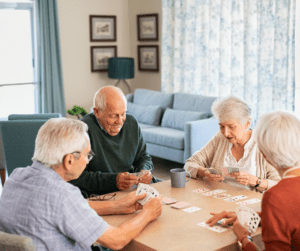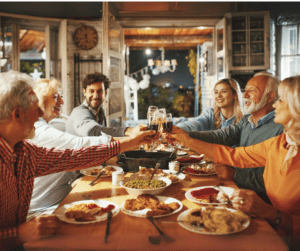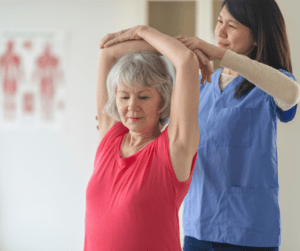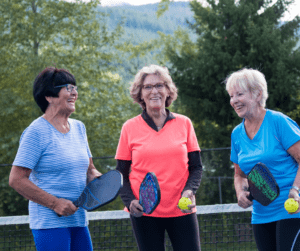National Game and Puzzle Week: Bringing Fun and Connection to Senior Living Communities
November 27th, 2024
National Game and Puzzle Week, celebrated annually during the last week of November, offers a unique opportunity to gather friends, family, and communities for a week of engaging, brain-teasing fun. The holiday season is already a time when people come together, and this particular week serves as a perfect chance to reconnect over board games, puzzles, and other forms of interactive entertainment. While people of all ages can enjoy these activities, senior living communities have especially embraced National Game and Puzzle Week as a way to enhance residents’ mental well-being, social connection, and overall quality of life.
In this blog, we’ll dive into what National Game and Puzzle Week is all about and explore the exciting ways senior living communities are getting involved.
The Origins and Purpose of National Game and Puzzle Week
National Game and Puzzle Week was created with the intention of encouraging families and friends to spend quality time together during the Thanksgiving holiday season. It’s a time when people are often gathered in the same place, making it ideal for activities that foster engagement and bonding. Games and puzzles have long been known to offer both entertainment and cognitive benefits. From stimulating problem-solving abilities to promoting teamwork, these activities provide a variety of mental and emotional advantages.
The week is not just about passing time; it’s about coming together in a meaningful way. It serves as a reminder of the simple joys that can be found in a good game of cards, a challenging puzzle, or a competitive round of Scrabble. But beyond family gatherings, senior living communities have realized the immense value that National Game and Puzzle Week holds for their residents.
The Importance of Games and Puzzles for Seniors
As people age, staying mentally sharp and socially engaged becomes increasingly important. Research has shown that participating in mentally stimulating activities like puzzles and games can help reduce the risk of cognitive decline and even conditions such as dementia and Alzheimer’s disease. In addition to cognitive benefits, games and puzzles also offer emotional and social perks, especially for older adults living in communal settings.
Here are some key benefits of games and puzzles for seniors:
- Cognitive Stimulation: Games such as chess, bridge, Sudoku, and crosswords challenge the brain and can help maintain cognitive function. For older adults, this can translate into better memory, problem-solving skills, and attention to detail.
- Social Interaction: Playing games in a group setting allows older adults to bond with one another, share laughter, and create new friendships. This is crucial in combatting feelings of loneliness and isolation, which can be common in older adults.
- Stress Relief: Games are a great way to relax and unwind. For many older adults, the competitive yet light-hearted atmosphere of game-playing helps reduce stress and anxiety, contributing to a more positive mental state.
Physical Dexterity: Many tabletop games and puzzles require fine motor skills, such as handling cards or placing puzzle pieces. These activities can help older adults maintain physical coordination and dexterity.
How Senior Living Communities Are Celebrating National Game and Puzzle Week
Senior living communities have increasingly recognized the value of incorporating games and puzzles into their activity calendars, especially during National Game and Puzzle Week. Many communities see this week as an opportunity to create exciting, enriching programs that engage residents of all skill levels.
Here’s a look at how some senior living communities are participating:
1. Game Tournaments
Senior living communities often organize game tournaments that span the entire week. Popular games include:
- Bridge and Poker: Card games like bridge and hearts are favorites among older adults. They require strategy, concentration, and social interaction, making them ideal for stimulating cognitive functions while fostering a sense of community.
- Scrabble Competitions: Scrabble not only sharpens vocabulary and spelling skills, but it also allows for lighthearted competition. Many senior living communities host Scrabble tournaments, with residents going head-to-head to claim the title of Scrabble champion.
Chess Matches: Chess is another beloved game that challenges players to think several steps ahead. Communities may organize chess matches or even chess clubs, where residents can hone their skills throughout the week.
2. Puzzle Challenges
Puzzles provide a quieter but equally engaging way for older adults to challenge their minds. Many communities create dedicated “Puzzle Rooms” where residents can work on jigsaw puzzles together. Often, large puzzles (1,000+ pieces) are set up, encouraging residents to collaborate and work toward a common goal. This collaborative effort fosters teamwork and offers a sense of accomplishment once the puzzle is complete.
3. Intergenerational Game Days
National Game and Puzzle Week offers an excellent opportunity for senior living communities to engage with the broader community, particularly younger generations. Many communities host Intergenerational Game Days, where family members—children, grandchildren, or even local school groups—are invited to spend time playing games with older adults. These events provide a fun and meaningful way for residents to bond with younger people, bridging the generation gap and creating lasting memories.
4. Technology-Enhanced Games
While traditional board games and puzzles are always a hit, some senior living communities are embracing technology to bring a modern twist to game-playing. Using devices like tablets or interactive touchscreens, residents can play digital puzzles, trivia games, or virtual versions of classic board games. These tech-enhanced options are particularly appealing to residents who might have mobility challenges or visual impairments, as they offer adjustable settings to make gameplay more accessible.
5. Trivia Nights and Brain Teasers
Trivia nights are a popular activity during National Game and Puzzle Week. Senior living communities often organize themed trivia events, where residents can form teams and test their knowledge on a variety of topics—from history and pop culture to geography and sports. In addition to trivia, communities may include brain teasers and riddles as part of the week’s activities, providing residents with a fun mental workout.
The Social Impact of Games in Senior Living Communities
Beyond the mental and physical benefits, National Game and Puzzle Week plays an important role in promoting social inclusion. In senior living communities, it’s common for residents to form smaller social circles, sometimes leading to feelings of exclusion among others. Game and puzzle events help break down these social barriers by bringing residents together in a structured but casual environment. Group activities encourage mingling, teamwork, and the development of new friendships, all of which contribute to a stronger sense of community.
For many older adults, these events also offer a renewed sense of purpose. The excitement of competition, the satisfaction of completing a puzzle, and the joy of shared experiences create a vibrant and engaging atmosphere.
National Game and Puzzle Week is more than just a week of fun—it’s a powerful tool for enhancing the mental, emotional, and social well-being of older adults in living communities. By participating in games and puzzles, older adults can keep their minds sharp, form meaningful connections, and experience the joy of friendly competition. As senior living communities continue to expand their activities, events like National Game and Puzzle Week are sure to remain highlights on the calendar, bringing residents together in ways that are both enjoyable and enriching.
So, if you’re in a senior living community or know someone who is, take the time to celebrate this week of puzzles, games, and camaraderie—it’s good for the brain, the heart, and the soul!
At Grace Management, Inc., we believe in fostering vibrant, engaging communities that enrich the lives of our residents. Our senior living communities embrace programs like National Game and Puzzle Week as opportunities to promote social connections, mental stimulation, and physical well-being. By offering a variety of activities designed to enhance the overall quality of life, we ensure that every resident can find joy and purpose in their daily experiences. To learn more about our communities and the unique programs we offer, visit Grace Management, Inc..










